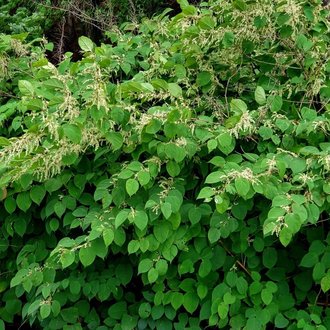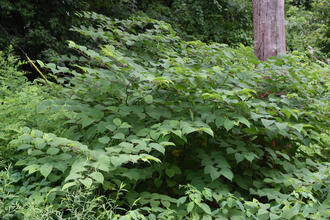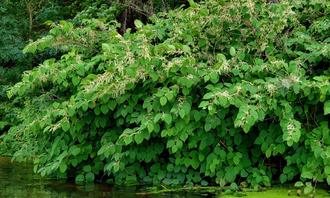Japanese Knotweed (Reynoutria japonica Houtt.)
Also classified as Polygonum cuspidatum Siebold & Zucc., Fallopia japonica (Houtt.) Ronse Decr., Polygonum japonicum (Houtt.) S.L.Welsh.
↑Summary
A tall, thicket-forming herbaceous perennial plant native to east Asia. Widely established in North America and Europe, where it is often considered one of the most damaging and difficult-to-eradicate invasive plants.
↑Control
Control of this species is difficult due to its robust nature, ability to resprout, and ability to spread vegetatively over long distances. Control methods include mechanical control, hericide, and introducing competition from other plants; often control is most effective if all three methods are combined.
Understanding the nature and extent of an infestation is a key. Control attempts will be futile if the plant is spreading vegetatively from a larger, more vigorous patch, such as one growing on the other side of a wall or fence. In this case, the vigorous source patch must be killed.
Herbicide application to the foliage is most effective in late summer to early fall, usually from July onward, after the plant has flowered and when it is returning energy stores to the roots, as this process leads more absorbed herbicide to be transported into the roots where it eventually kills the plant. Herbicide sprayed earlier in the growing season will often only top-kill the plant and have little to no effect on the rhizomes.
On the other hand, mechanical control, in particular cutting, is most effective early in the growing season. If you only have one opportunity to cut, the optimal timing is usually around the beginning of June, right after the plant has reached its maximum height. Cutting earlier will result in a more vigorous resprout, which can be more effective if you follow up by a second cutting, but less effective if it is carried out only once a season.
If it is not possible to cut the entire patch, work from the outside of a patch inward as this will help reduce the patch's spread and also maximize competition from surrounding vegetation, whereas an incomplete control attempt at the middle of a vigorous patch will quickly see its progress erased. Top-killing stems of this plant often stimulates vegetative spread so follow-up around the edge of a patch to monitor for new spread is critical.
Smothering, covering with a tarp or thick material, often then covering it with mulch, can also be combined with manual control, on patches that have already been weakened. However smothering is ineffective against vigorous patches as stems of vigorous plants will pentrate most fabrics with ease. Smothering often causes additional problems, especially in the absence of follow-up; if a non-biodegradable tarp or landscape paper is used, extra work must be done to remove it later so that non-biodegradable litter is not left in the environment
Depletion of rhizomes energy stores through cutting and/or smothering can eventually kill a patch on its own, but this approach can synergize with herbicide application. A weakened patch will be less vigorous and more likely to be completely killed by subsequent herbicide application.
There is little native vegetation that grows as tall as Japanese knotweed, but low-growing herbaceous vegetation still provides competition that can hinder its re-establishment and spread in an area. Trees, especially species that cast dense shade, can also hinder the growth and survival of Japanese knotweed in the understory.
↑Uses
In the past, this plant was widely planted in North America to control erosion, where it was valued for its quick establishment, especially on riparian sites. It was also occasionally used in landscaping.
It is rarely planted nowadays due to its invasive nature, and considerable effort is put towards its control.
↑Links & External Resources
• Polygonum cuspidatum (Japanese Knotweed) | USDA PLANTS Database (About This Site)
• Reynoutria japonica | Biota of North America Project (BONAP) (About This Site)
• Fallopia japonica | Go Botany (About This Site)
• Reynoutria japonica | NatureServe Explorer (About This Site)
• Fallopia japonica | Flora of North America (About This Site)
• Reynoutria japonica (Japanese Knotweed) | Illinois Wildflowers (About This Site)
• Fallopia japonica | Missouri Plants (About This Site)
• Japanese Knotweed | Maryland Biodiversity Project (About This Site)
• Reynoutria japonica Houtt. | Plants of the World Online (POWO) (About This Site)
• Reynoutria japonica Houttuyn (Japanese Knotweed) | Digital Atlas of the Virginia Flora (About This Site)





